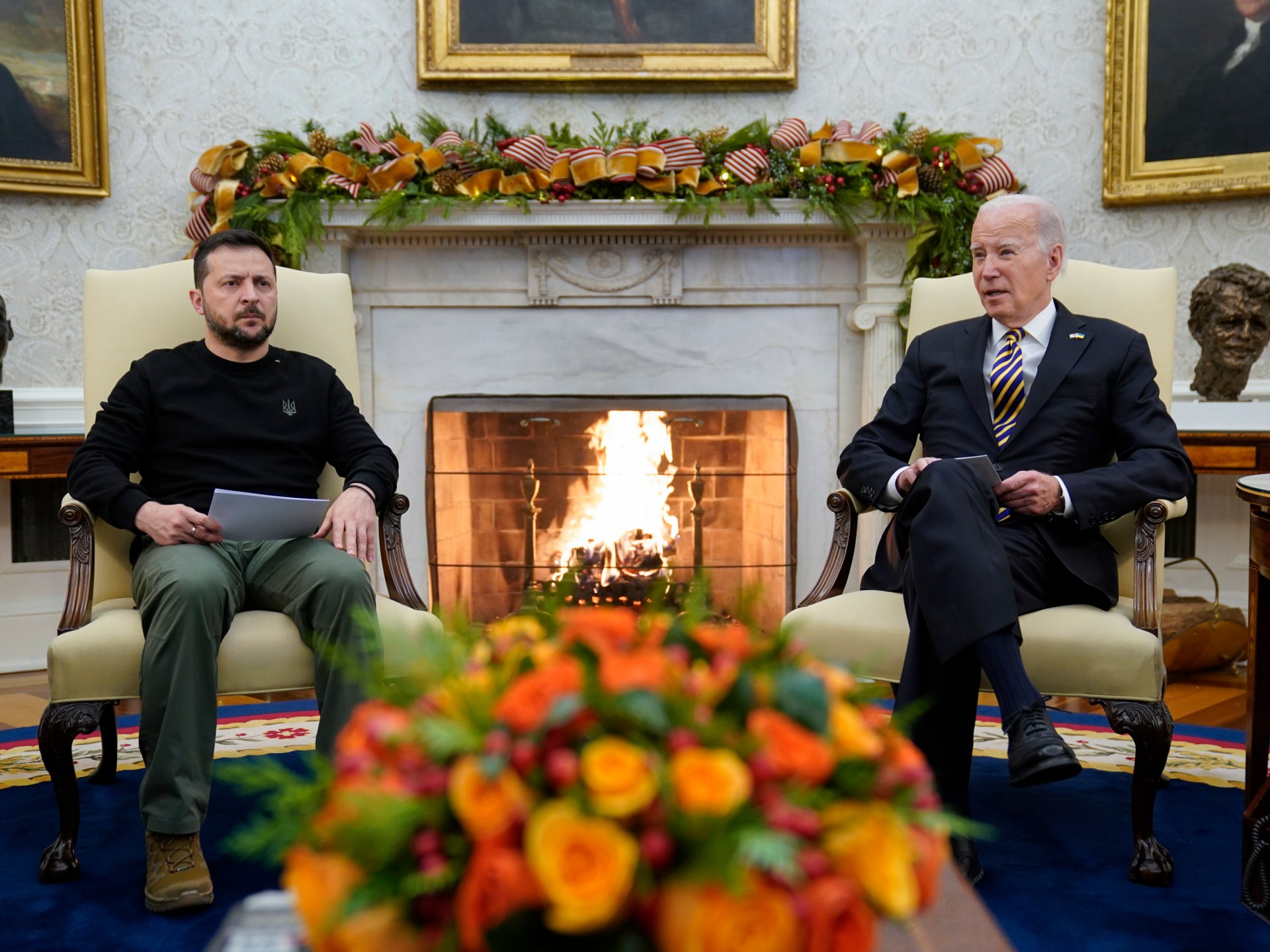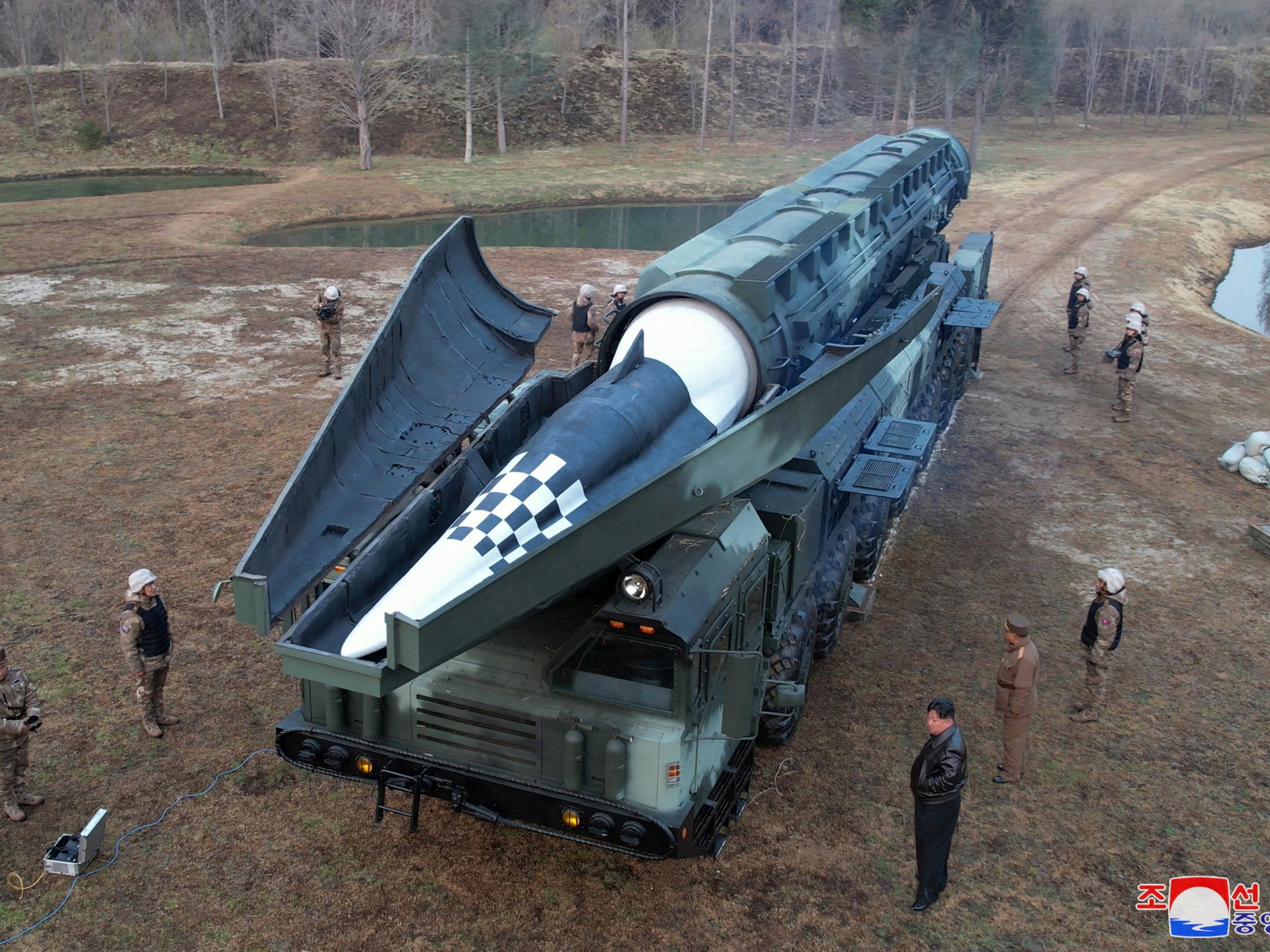‘Switch to defence’: Ukraine faces difficult 2024 amid aid, arms setbacks | Russia-Ukraine war
Kyiv, Ukraine – Whenever Svitlana Matvienko hears the wailing of air raid sirens, she goes down to the nearby subterranean shopping mall.
There, a barista she’s on a first-name basis with gets her a large latte, and Matvienko clacks away on her tiny silver laptop, sitting next to several dozen others waiting out the air raid.
“I’m like a little Pavlov dog, but the sirens make me drool for coffee,” the 52-year-old freelance marketing expert told Al Jazeera with a sense of self-deprecating humour that helps Ukrainians cope with the war.
The crowd around her is minuscule in comparison with last year, when hundreds of people thronged the same Metrograd mall, often staying for the night with their weeping children and squealing pets.
To Matvienko, the December 15 air raid was yet another multimillion-dollar exercise in the futility of Russia’s war effort, with all the cruise missiles and kamikaze drones shot down and no casualties reported.
And when asked about what awaits her and all of Ukraine in 2024, the ginger-haired, petite mother of two pointed up, as if her manicured forefinger could pierce the ceiling towards the grey sky and howling sirens, and said: “A lot more of this.”
This year has been uneasy and somewhat disappointing to many Ukrainians.
The long-awaited counteroffensive in eastern and southern regions stalled as Russian bombardment of urban centres resumed to sow panic and destroy power stations and central heating facilities.
“Because the summer counteroffensive lacked notable results, Ukrainians got back to feeling danger and threat that seemed to have subdued as they were getting used to the ongoing war,” Svitlana Chunikhina, vice president of the Association of Political Psychologists, a group in Kyiv, told Al Jazeera.
“We need to adapt to the war again, to correct expectations and life strategies taking into account more realistic estimates,” she said.
The counteroffensive’s fiasco seems sobering in comparison with last year’s emotional rollercoaster, when Russian troops horrified Ukraine by advancing from three directions – only to withdraw from around Kyiv and northern regions and to suffer a string of humiliating defeats in the east and south.
This winter, the tables seem to have turned.
“Now is the time to switch to defence” along the crescent-shaped front line that traverses eastern and southern Ukraine for more than 1,000km (600 miles), says Kyiv-based analyst Igar Tyshkevich.
“For the winter campaign, Ukraine’s logic is to hold the front. Hold the Black Sea, keep the ports open, work the political field to guarantee the reception of military aid as the spring approaches,” he told Al Jazeera.
Kyiv’s manpower and arsenals are too depleted to go on the offensive next year, according to some top Ukrainian military experts.
“We don’t have the resources for next year’s operation,” Lieutenant General Ihor Romanenko, the former deputy chief of the General Staff of the Ukrainian Armed Forces, told Al Jazeera.
Polls show that the number of Ukrainians who believe that the war should go on until Ukraine regains all lost territories, including the Crimean peninsula that Russia annexed in 2014, is going down, albeit insignificantly.
Sixty percent believe in Kyiv’s imminent military triumph, as opposed to 70 percent last year, according to a Gallup poll released in October. And almost a third of those polled – 31 percent – think that peace talks with Russia should begin “as soon as possible,” compared with 26 percent last year, the poll said.
Most of the supporters of immediate negotiations come from southern (41 percent) and eastern (39 percent) Ukraine, where most of the hostilities took place this year, the poll said.
Meanwhile, Israel’s war on Gaza has eclipsed the Russia-Ukraine war in the Western media and halls of power as aid to Ukraine has dwindled or been suspended.
The aid has been keeping Kyiv afloat since the war began in February 2022 – and will be the key factor shaping the future and stability of Ukraine’s economy, according to Kyiv-based analyst Aleksey Kusch.
“In theory, Ukraine can hold on for between six months and a year on its own. But that will require the freezing of a string of budget articles,” he told Al Jazeera.
Only by 2025 will Ukraine achieve a “factor of safety” if some refugees return and Kyiv gets sizable investments, he said.
More than six million people left Ukraine last year, mostly to Poland and other Eastern European nations, and another eight million have been displaced within the France-sized nation.
Another key contributor to the economic growth will be the unblocking of Ukrainian ports on the Black Sea and Azov Sea to fully resume the shipment of grain and steel, a scenario that will require Kyiv to continue to assault Russia’s navy, Kusch said.
This year, Ukraine’s economy showed small signs of recovery after 2022’s freefall, when the gross domestic product shrank by a third. This year, the GDP will have grown by 2 percent – and may gain another 3.2 percent in 2024, the International Monetary Fund said in October.
It said the “stronger than expected” growth in domestic demand reflected the adaptation to the invasion and reversed the prediction of a 3 percent shrinkage for 2023.
Another source of cautious optimism is the prospect of Ukraine joining NATO and the European Union – something that would safeguard the country from Russia politically and economically.
At a summit in July, NATO member states agreed to simplify Ukraine’s path to membership, although they did not say when it could join. And in mid-December, the European Union decided to open membership talks for Kyiv, despite Hungary’s objections over the “mistreatment” of ethnic Hungarians in western Ukraine.
The overwhelming majority of Ukrainians believe that their nation would join NATO (69 percent) and the EU (73 percent) within a decade, the Gallup poll showed.
In 2024, Ukraine is also not going to see a change of leadership. All political parties with a presence in the Verkhovna Rada, Ukraine’s lower house of parliament, agreed in mid-November to postpone the presidential and parliamentary votes until the war is over.
They said that too many Ukrainians live in Russia-occupied areas or fled abroad to cast their ballots.
President Volodymyr Zelenskyy remains the country’s most popular political figure with an approval rating of 62 percent, according to a poll by the Kyiv Sociology Institute released in early December. His popularity went down from a staggering 84 percent in December 2022, largely due to the counteroffensive’s failure and corruption scandals in the military.
His only possible political rival is Valery Zaluzhny, the commander-in-chief of Ukraine’s Armed Forces, whose rating went up to a stratospheric 88 percent, the poll said.
But in extremely rare interviews, the four-star general has never indicated any political ambitions.
“The ratings are high because he is silent,” a source close to him told Al Jazeera. “Everyone sees him as this super reliable father figure, the protector, but nobody knows about his political preferences.”
Check out our Latest News and Follow us at Facebook
Original Source







